Sociology 472 - Criminological Theory: Analyzing Crime with Theories
VerifiedAdded on 2022/10/15
|6
|1396
|404
Essay
AI Summary
This essay provides an analysis of the Kala Brown kidnapping case, examining the crime through the lens of several criminological theories. The essay begins with a description of the crime, detailing the events of the kidnapping and subsequent murders committed by Todd Kohlhepp. It then delves into the application of five key criminological theories: deterrence theory, rational choice theory, routine activities theory, biological/biosocial theory, and psychological theory. For each theory, the essay explains its core principles and assesses its ability to explain Kohlhepp's actions. The analysis considers whether the theories provide a good explanation for the crime, evaluating their strengths and limitations in this specific context. The essay ultimately concludes that the biological and psychological theories offer the most compelling explanations for Kohlhepp's criminal behavior, highlighting his pre-existing mental health issues and troubled childhood.
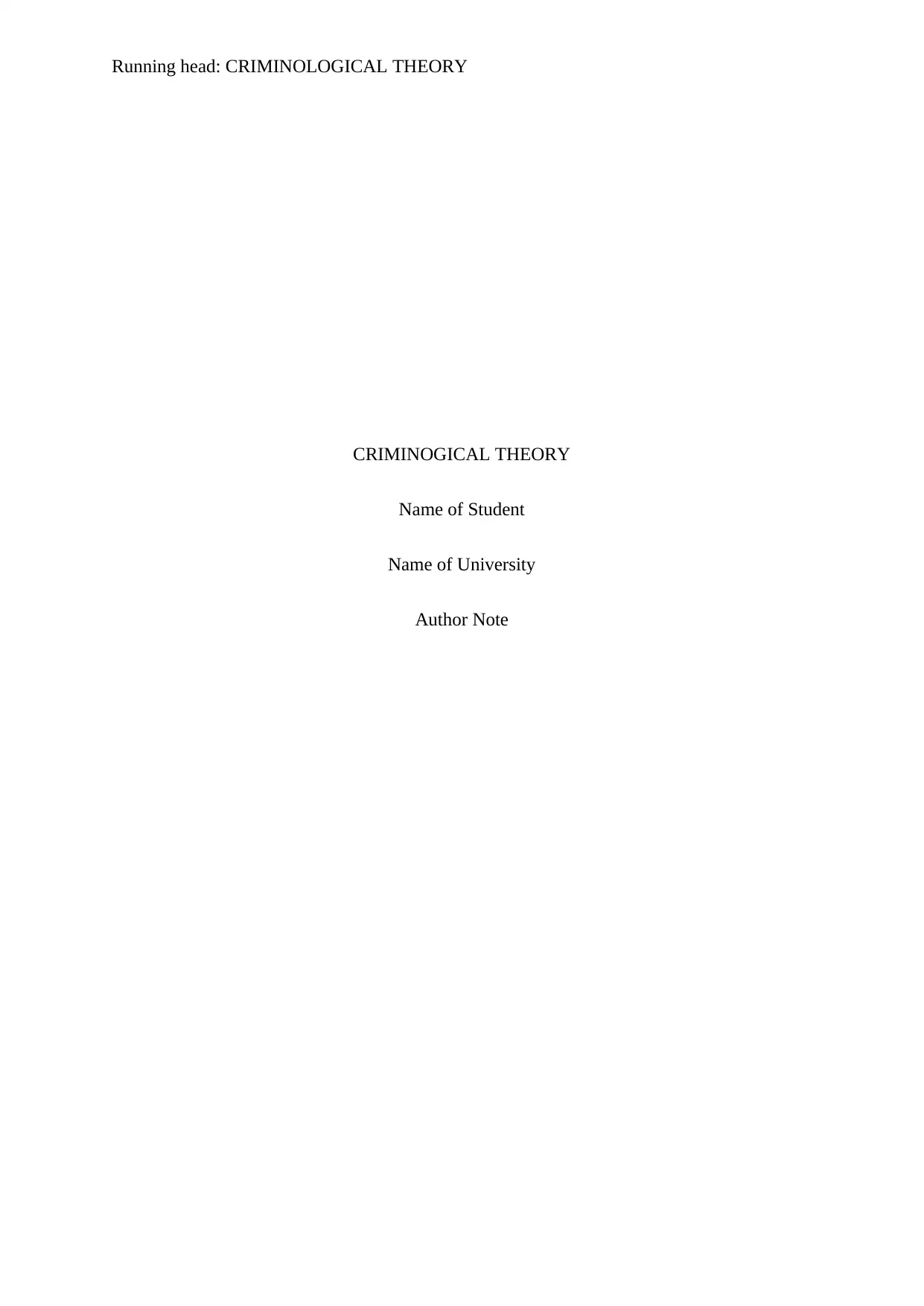
Running head: CRIMINOLOGICAL THEORY
CRIMINOGICAL THEORY
Name of Student
Name of University
Author Note
CRIMINOGICAL THEORY
Name of Student
Name of University
Author Note
Paraphrase This Document
Need a fresh take? Get an instant paraphrase of this document with our AI Paraphraser
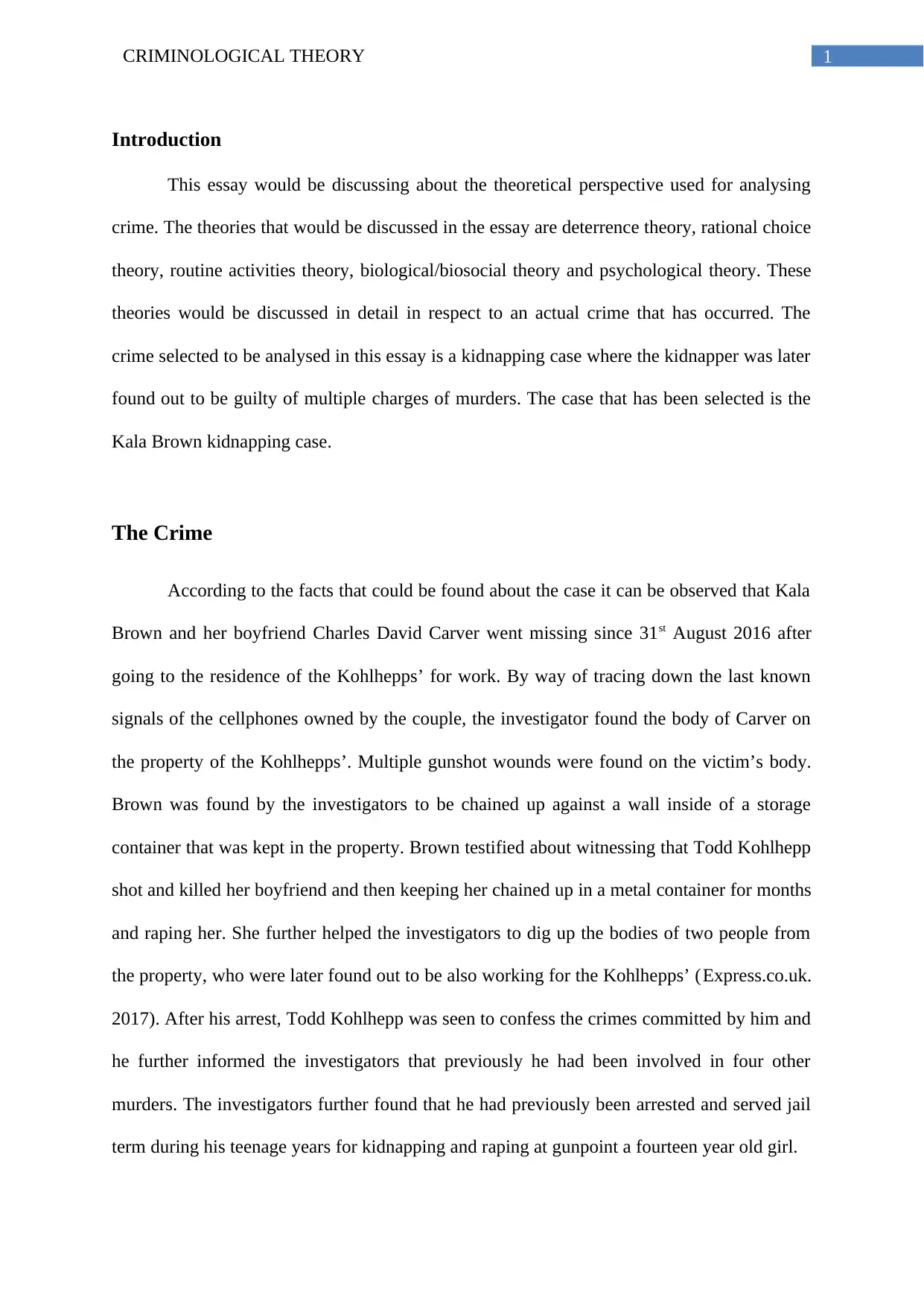
1CRIMINOLOGICAL THEORY
Introduction
This essay would be discussing about the theoretical perspective used for analysing
crime. The theories that would be discussed in the essay are deterrence theory, rational choice
theory, routine activities theory, biological/biosocial theory and psychological theory. These
theories would be discussed in detail in respect to an actual crime that has occurred. The
crime selected to be analysed in this essay is a kidnapping case where the kidnapper was later
found out to be guilty of multiple charges of murders. The case that has been selected is the
Kala Brown kidnapping case.
The Crime
According to the facts that could be found about the case it can be observed that Kala
Brown and her boyfriend Charles David Carver went missing since 31st August 2016 after
going to the residence of the Kohlhepps’ for work. By way of tracing down the last known
signals of the cellphones owned by the couple, the investigator found the body of Carver on
the property of the Kohlhepps’. Multiple gunshot wounds were found on the victim’s body.
Brown was found by the investigators to be chained up against a wall inside of a storage
container that was kept in the property. Brown testified about witnessing that Todd Kohlhepp
shot and killed her boyfriend and then keeping her chained up in a metal container for months
and raping her. She further helped the investigators to dig up the bodies of two people from
the property, who were later found out to be also working for the Kohlhepps’ (Express.co.uk.
2017). After his arrest, Todd Kohlhepp was seen to confess the crimes committed by him and
he further informed the investigators that previously he had been involved in four other
murders. The investigators further found that he had previously been arrested and served jail
term during his teenage years for kidnapping and raping at gunpoint a fourteen year old girl.
Introduction
This essay would be discussing about the theoretical perspective used for analysing
crime. The theories that would be discussed in the essay are deterrence theory, rational choice
theory, routine activities theory, biological/biosocial theory and psychological theory. These
theories would be discussed in detail in respect to an actual crime that has occurred. The
crime selected to be analysed in this essay is a kidnapping case where the kidnapper was later
found out to be guilty of multiple charges of murders. The case that has been selected is the
Kala Brown kidnapping case.
The Crime
According to the facts that could be found about the case it can be observed that Kala
Brown and her boyfriend Charles David Carver went missing since 31st August 2016 after
going to the residence of the Kohlhepps’ for work. By way of tracing down the last known
signals of the cellphones owned by the couple, the investigator found the body of Carver on
the property of the Kohlhepps’. Multiple gunshot wounds were found on the victim’s body.
Brown was found by the investigators to be chained up against a wall inside of a storage
container that was kept in the property. Brown testified about witnessing that Todd Kohlhepp
shot and killed her boyfriend and then keeping her chained up in a metal container for months
and raping her. She further helped the investigators to dig up the bodies of two people from
the property, who were later found out to be also working for the Kohlhepps’ (Express.co.uk.
2017). After his arrest, Todd Kohlhepp was seen to confess the crimes committed by him and
he further informed the investigators that previously he had been involved in four other
murders. The investigators further found that he had previously been arrested and served jail
term during his teenage years for kidnapping and raping at gunpoint a fourteen year old girl.
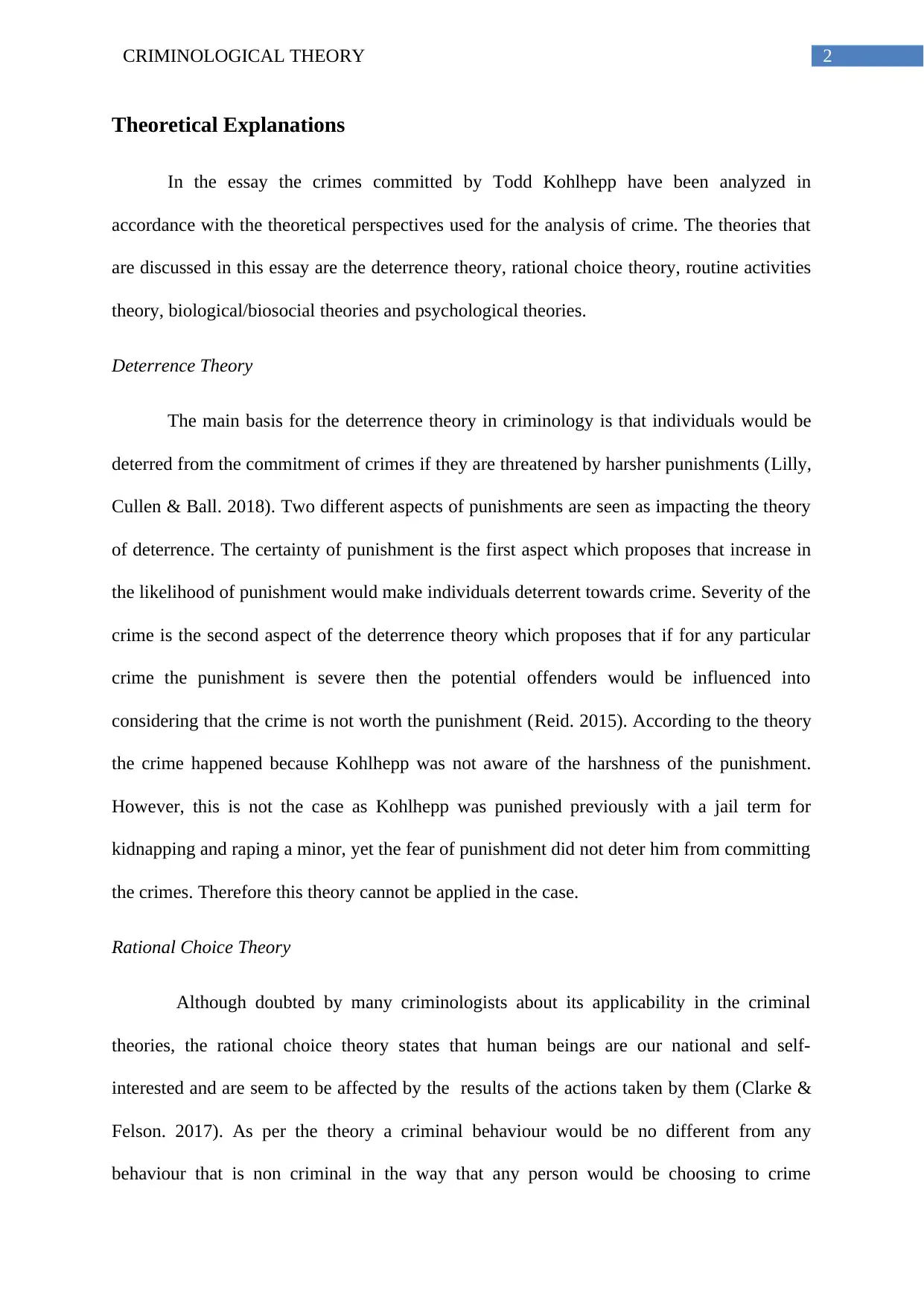
2CRIMINOLOGICAL THEORY
Theoretical Explanations
In the essay the crimes committed by Todd Kohlhepp have been analyzed in
accordance with the theoretical perspectives used for the analysis of crime. The theories that
are discussed in this essay are the deterrence theory, rational choice theory, routine activities
theory, biological/biosocial theories and psychological theories.
Deterrence Theory
The main basis for the deterrence theory in criminology is that individuals would be
deterred from the commitment of crimes if they are threatened by harsher punishments (Lilly,
Cullen & Ball. 2018). Two different aspects of punishments are seen as impacting the theory
of deterrence. The certainty of punishment is the first aspect which proposes that increase in
the likelihood of punishment would make individuals deterrent towards crime. Severity of the
crime is the second aspect of the deterrence theory which proposes that if for any particular
crime the punishment is severe then the potential offenders would be influenced into
considering that the crime is not worth the punishment (Reid. 2015). According to the theory
the crime happened because Kohlhepp was not aware of the harshness of the punishment.
However, this is not the case as Kohlhepp was punished previously with a jail term for
kidnapping and raping a minor, yet the fear of punishment did not deter him from committing
the crimes. Therefore this theory cannot be applied in the case.
Rational Choice Theory
Although doubted by many criminologists about its applicability in the criminal
theories, the rational choice theory states that human beings are our national and self-
interested and are seem to be affected by the results of the actions taken by them (Clarke &
Felson. 2017). As per the theory a criminal behaviour would be no different from any
behaviour that is non criminal in the way that any person would be choosing to crime
Theoretical Explanations
In the essay the crimes committed by Todd Kohlhepp have been analyzed in
accordance with the theoretical perspectives used for the analysis of crime. The theories that
are discussed in this essay are the deterrence theory, rational choice theory, routine activities
theory, biological/biosocial theories and psychological theories.
Deterrence Theory
The main basis for the deterrence theory in criminology is that individuals would be
deterred from the commitment of crimes if they are threatened by harsher punishments (Lilly,
Cullen & Ball. 2018). Two different aspects of punishments are seen as impacting the theory
of deterrence. The certainty of punishment is the first aspect which proposes that increase in
the likelihood of punishment would make individuals deterrent towards crime. Severity of the
crime is the second aspect of the deterrence theory which proposes that if for any particular
crime the punishment is severe then the potential offenders would be influenced into
considering that the crime is not worth the punishment (Reid. 2015). According to the theory
the crime happened because Kohlhepp was not aware of the harshness of the punishment.
However, this is not the case as Kohlhepp was punished previously with a jail term for
kidnapping and raping a minor, yet the fear of punishment did not deter him from committing
the crimes. Therefore this theory cannot be applied in the case.
Rational Choice Theory
Although doubted by many criminologists about its applicability in the criminal
theories, the rational choice theory states that human beings are our national and self-
interested and are seem to be affected by the results of the actions taken by them (Clarke &
Felson. 2017). As per the theory a criminal behaviour would be no different from any
behaviour that is non criminal in the way that any person would be choosing to crime
⊘ This is a preview!⊘
Do you want full access?
Subscribe today to unlock all pages.

Trusted by 1+ million students worldwide
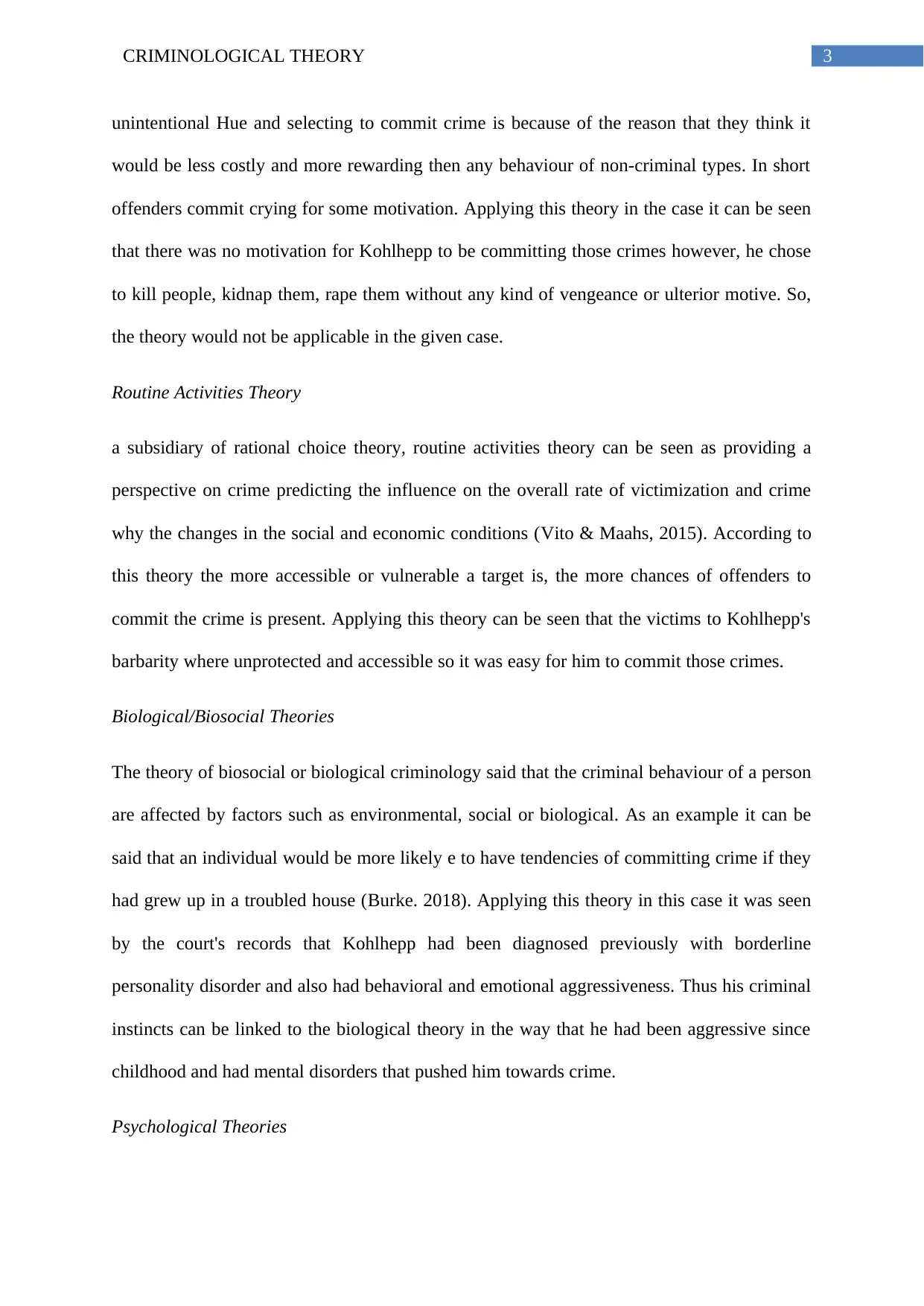
3CRIMINOLOGICAL THEORY
unintentional Hue and selecting to commit crime is because of the reason that they think it
would be less costly and more rewarding then any behaviour of non-criminal types. In short
offenders commit crying for some motivation. Applying this theory in the case it can be seen
that there was no motivation for Kohlhepp to be committing those crimes however, he chose
to kill people, kidnap them, rape them without any kind of vengeance or ulterior motive. So,
the theory would not be applicable in the given case.
Routine Activities Theory
a subsidiary of rational choice theory, routine activities theory can be seen as providing a
perspective on crime predicting the influence on the overall rate of victimization and crime
why the changes in the social and economic conditions (Vito & Maahs, 2015). According to
this theory the more accessible or vulnerable a target is, the more chances of offenders to
commit the crime is present. Applying this theory can be seen that the victims to Kohlhepp's
barbarity where unprotected and accessible so it was easy for him to commit those crimes.
Biological/Biosocial Theories
The theory of biosocial or biological criminology said that the criminal behaviour of a person
are affected by factors such as environmental, social or biological. As an example it can be
said that an individual would be more likely e to have tendencies of committing crime if they
had grew up in a troubled house (Burke. 2018). Applying this theory in this case it was seen
by the court's records that Kohlhepp had been diagnosed previously with borderline
personality disorder and also had behavioral and emotional aggressiveness. Thus his criminal
instincts can be linked to the biological theory in the way that he had been aggressive since
childhood and had mental disorders that pushed him towards crime.
Psychological Theories
unintentional Hue and selecting to commit crime is because of the reason that they think it
would be less costly and more rewarding then any behaviour of non-criminal types. In short
offenders commit crying for some motivation. Applying this theory in the case it can be seen
that there was no motivation for Kohlhepp to be committing those crimes however, he chose
to kill people, kidnap them, rape them without any kind of vengeance or ulterior motive. So,
the theory would not be applicable in the given case.
Routine Activities Theory
a subsidiary of rational choice theory, routine activities theory can be seen as providing a
perspective on crime predicting the influence on the overall rate of victimization and crime
why the changes in the social and economic conditions (Vito & Maahs, 2015). According to
this theory the more accessible or vulnerable a target is, the more chances of offenders to
commit the crime is present. Applying this theory can be seen that the victims to Kohlhepp's
barbarity where unprotected and accessible so it was easy for him to commit those crimes.
Biological/Biosocial Theories
The theory of biosocial or biological criminology said that the criminal behaviour of a person
are affected by factors such as environmental, social or biological. As an example it can be
said that an individual would be more likely e to have tendencies of committing crime if they
had grew up in a troubled house (Burke. 2018). Applying this theory in this case it was seen
by the court's records that Kohlhepp had been diagnosed previously with borderline
personality disorder and also had behavioral and emotional aggressiveness. Thus his criminal
instincts can be linked to the biological theory in the way that he had been aggressive since
childhood and had mental disorders that pushed him towards crime.
Psychological Theories
Paraphrase This Document
Need a fresh take? Get an instant paraphrase of this document with our AI Paraphraser
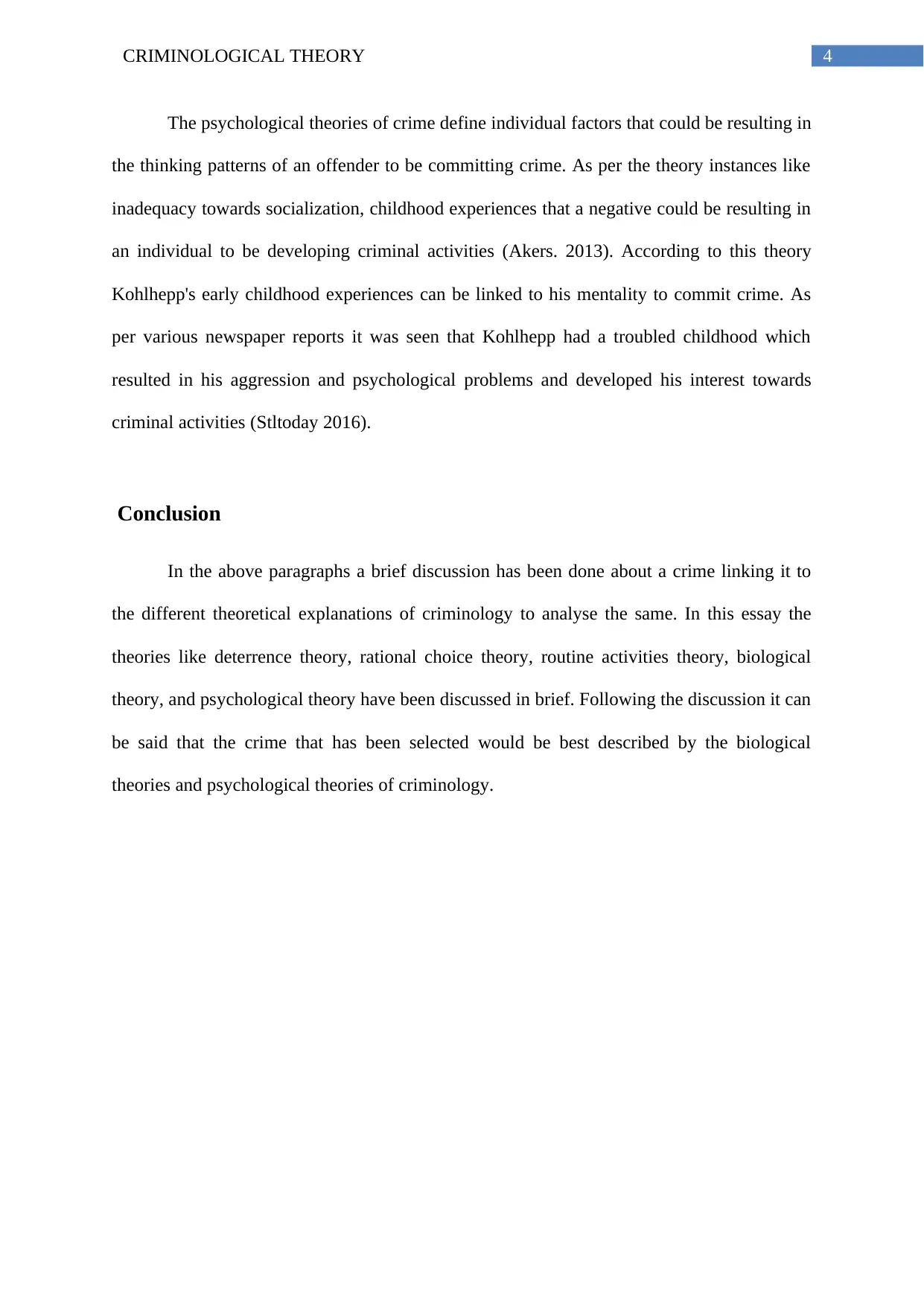
4CRIMINOLOGICAL THEORY
The psychological theories of crime define individual factors that could be resulting in
the thinking patterns of an offender to be committing crime. As per the theory instances like
inadequacy towards socialization, childhood experiences that a negative could be resulting in
an individual to be developing criminal activities (Akers. 2013). According to this theory
Kohlhepp's early childhood experiences can be linked to his mentality to commit crime. As
per various newspaper reports it was seen that Kohlhepp had a troubled childhood which
resulted in his aggression and psychological problems and developed his interest towards
criminal activities (Stltoday 2016).
Conclusion
In the above paragraphs a brief discussion has been done about a crime linking it to
the different theoretical explanations of criminology to analyse the same. In this essay the
theories like deterrence theory, rational choice theory, routine activities theory, biological
theory, and psychological theory have been discussed in brief. Following the discussion it can
be said that the crime that has been selected would be best described by the biological
theories and psychological theories of criminology.
The psychological theories of crime define individual factors that could be resulting in
the thinking patterns of an offender to be committing crime. As per the theory instances like
inadequacy towards socialization, childhood experiences that a negative could be resulting in
an individual to be developing criminal activities (Akers. 2013). According to this theory
Kohlhepp's early childhood experiences can be linked to his mentality to commit crime. As
per various newspaper reports it was seen that Kohlhepp had a troubled childhood which
resulted in his aggression and psychological problems and developed his interest towards
criminal activities (Stltoday 2016).
Conclusion
In the above paragraphs a brief discussion has been done about a crime linking it to
the different theoretical explanations of criminology to analyse the same. In this essay the
theories like deterrence theory, rational choice theory, routine activities theory, biological
theory, and psychological theory have been discussed in brief. Following the discussion it can
be said that the crime that has been selected would be best described by the biological
theories and psychological theories of criminology.
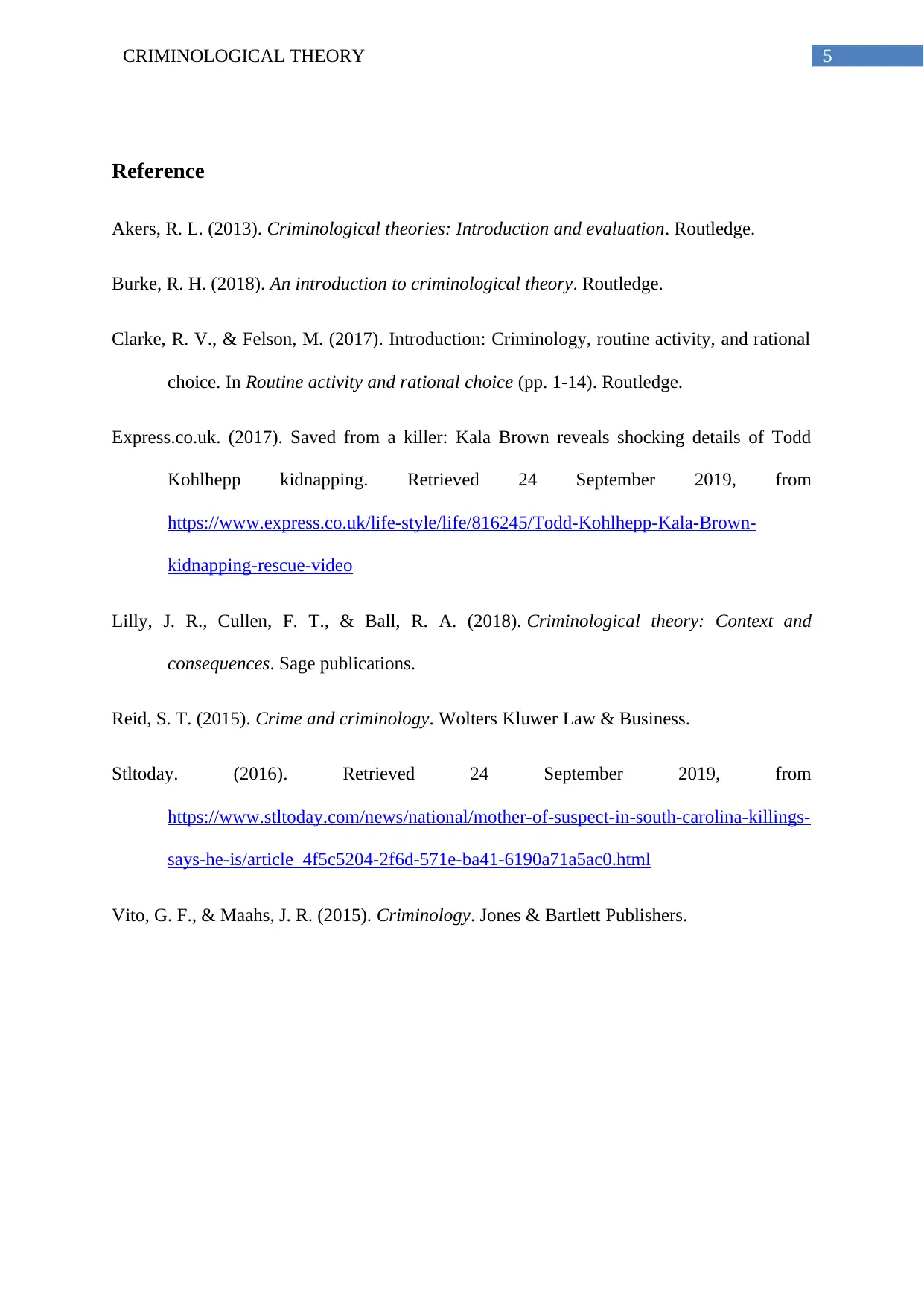
5CRIMINOLOGICAL THEORY
Reference
Akers, R. L. (2013). Criminological theories: Introduction and evaluation. Routledge.
Burke, R. H. (2018). An introduction to criminological theory. Routledge.
Clarke, R. V., & Felson, M. (2017). Introduction: Criminology, routine activity, and rational
choice. In Routine activity and rational choice (pp. 1-14). Routledge.
Express.co.uk. (2017). Saved from a killer: Kala Brown reveals shocking details of Todd
Kohlhepp kidnapping. Retrieved 24 September 2019, from
https://www.express.co.uk/life-style/life/816245/Todd-Kohlhepp-Kala-Brown-
kidnapping-rescue-video
Lilly, J. R., Cullen, F. T., & Ball, R. A. (2018). Criminological theory: Context and
consequences. Sage publications.
Reid, S. T. (2015). Crime and criminology. Wolters Kluwer Law & Business.
Stltoday. (2016). Retrieved 24 September 2019, from
https://www.stltoday.com/news/national/mother-of-suspect-in-south-carolina-killings-
says-he-is/article_4f5c5204-2f6d-571e-ba41-6190a71a5ac0.html
Vito, G. F., & Maahs, J. R. (2015). Criminology. Jones & Bartlett Publishers.
Reference
Akers, R. L. (2013). Criminological theories: Introduction and evaluation. Routledge.
Burke, R. H. (2018). An introduction to criminological theory. Routledge.
Clarke, R. V., & Felson, M. (2017). Introduction: Criminology, routine activity, and rational
choice. In Routine activity and rational choice (pp. 1-14). Routledge.
Express.co.uk. (2017). Saved from a killer: Kala Brown reveals shocking details of Todd
Kohlhepp kidnapping. Retrieved 24 September 2019, from
https://www.express.co.uk/life-style/life/816245/Todd-Kohlhepp-Kala-Brown-
kidnapping-rescue-video
Lilly, J. R., Cullen, F. T., & Ball, R. A. (2018). Criminological theory: Context and
consequences. Sage publications.
Reid, S. T. (2015). Crime and criminology. Wolters Kluwer Law & Business.
Stltoday. (2016). Retrieved 24 September 2019, from
https://www.stltoday.com/news/national/mother-of-suspect-in-south-carolina-killings-
says-he-is/article_4f5c5204-2f6d-571e-ba41-6190a71a5ac0.html
Vito, G. F., & Maahs, J. R. (2015). Criminology. Jones & Bartlett Publishers.
⊘ This is a preview!⊘
Do you want full access?
Subscribe today to unlock all pages.

Trusted by 1+ million students worldwide
1 out of 6
Your All-in-One AI-Powered Toolkit for Academic Success.
+13062052269
info@desklib.com
Available 24*7 on WhatsApp / Email
![[object Object]](/_next/static/media/star-bottom.7253800d.svg)
Unlock your academic potential
Copyright © 2020–2025 A2Z Services. All Rights Reserved. Developed and managed by ZUCOL.
